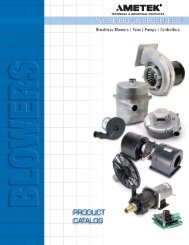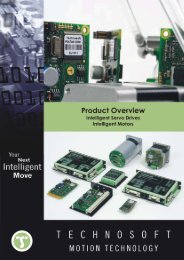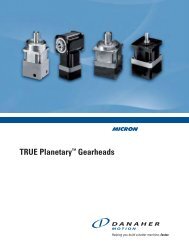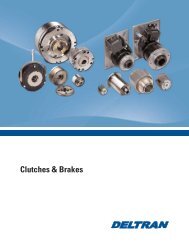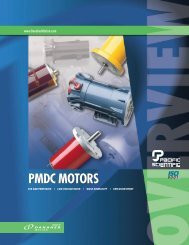Profile Rail Linear Guides
Profile Rail Linear Guides
Profile Rail Linear Guides
Create successful ePaper yourself
Turn your PDF publications into a flip-book with our unique Google optimized e-Paper software.
<strong>Linear</strong> Motion. Optimized.<br />
Installation Guidelines for 500 Series Ball, Roller, AccuMini and T-Series<br />
Figure 1<br />
P1<br />
Table 1. Parallelism Between Multiple <strong>Rail</strong>s, mm<br />
Preload<br />
Bearing Type Clearance 0,03 C † 0,08 C † 0,03 C †<br />
500 Series Ball <strong>Linear</strong> Guide<br />
15 .015 .010 .007 .003<br />
20 .017 .012 .008 .004<br />
25 .024 .016 .010 .005<br />
30 .024 .016 .010 .005<br />
35 .032 .021 .014 .008<br />
45 .036 .024 .016 .009<br />
500 Series Roller <strong>Linear</strong> Guide<br />
25 – .016 .010 .005<br />
35 – .012 .014 .008<br />
45 – .024 .016 .009<br />
55 – .026 .017 .010<br />
65 – .028 .018 .011<br />
AccuMini <strong>Linear</strong> Guide<br />
10 .009 .004 – –<br />
15 .011 .006 – –<br />
20 .013 .008 – –<br />
T-Series * <strong>Linear</strong> Guide<br />
15 .045 – – –<br />
20 .045 – – –<br />
25 .050 – – –<br />
30 .055 – – –<br />
35 .060 – – –<br />
† Where C = Dynamic Load Capacity<br />
Surface Preparation<br />
<strong>Profile</strong><strong>Rail</strong>* bearings are generally mounted to<br />
structures that are inherently stiffer than the rail. For<br />
this reason, the bearings tend to assume the orientation<br />
of the surfaces to which they are fastened, through<br />
bearing deflection. When a deflection is imposed upon<br />
a bearing, especially a preloaded one, resultant forces<br />
occur. These forces are transferred to the rolling<br />
elements and races, potentially resulting in an increase<br />
in system friction and a decrease in system resolution,<br />
precision and life.<br />
Various sources can contribute to the overall error of the<br />
mounting surfaces. These include the surface flatness<br />
of the base surfaces, the location and parallelism of<br />
the reference surfaces, and the attendant errors of the<br />
bearing as described within the accuracy classes.<br />
The surfaces that contact the base and reference<br />
edges may be milled, scraped, ground, or prepared<br />
by any other method that will produce a flat mounting<br />
surface free of inconsistencies, which would tend to<br />
distort or skew the bearing. A simple stone may be used<br />
to remove high spots. Dirt and debris should be cleaned<br />
off, as they could contribute to the inaccuracies.<br />
Associated with preload is a slight potential concavity<br />
of the carriage top surface. The preload is established<br />
when all the carriage screws are affixed to a planar<br />
surface, flattening the carriage base. Deviations<br />
affecting the planarity of the carriage mounting surface<br />
could result in a preload change.<br />
Mounting Tolerances<br />
The tolerances found in Tables 1 – 3 are intended to<br />
provide an installation for which the associated derating<br />
is negligible. These specifications are based upon the<br />
assumption that the structures of the application are<br />
infinitely rigid and are of consideration for the bearing<br />
reactions only.<br />
<strong>Rail</strong> Parallelism (See Figure 1)<br />
A variation in the distance between the rails will induce<br />
a shear or side load on the bearings.<br />
In order to minimize the effect of this shear load,<br />
tolerances for rail reference edge parallelism may be<br />
found in Table 1.<br />
92<br />
www.thomsonlinear.com





